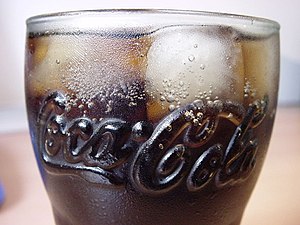Coca-Cola formula
Company founder Asa Candler initiated the veil of secrecy that surrounds the formula in 1891 as a publicity, marketing, and intellectual property protection strategy.
In 1925, when the loan had been repaid, Woodruff relocated the written formula to the Trust Company Bank (Truist Financial) in Atlanta.
[5][6] Coca leaves were used in Coca-Cola's preparation; the small amount of cocaine they contained – along with caffeine originally sourced from kola nuts – provided the drink's "tonic" quality.
[9] Some sources claim that coca leaf chemically processed to remove the cocaine remains part of the formula as a flavoring.
[18] Despite the implications of its name, there is no evidence that the current version of Coca-Cola syrup contains kola nut extract, which was originally included for its caffeine content.
[21] During the 1980s, most U.S. Coca-Cola bottlers switched their primary sweetening ingredient from cane sugar (sucrose) to the cheaper high-fructose corn syrup.
As of 2009[update], the only U.S. bottler still using sucrose year-round was the Coca-Cola Bottling Company of Cleveland, which serves northern Ohio and a portion of Pennsylvania.
Twelve-US-fluid-ounce (355 ml) glass bottles of sucrose-sweetened Coca-Cola imported from Mexico are available in many U.S. markets for those consumers who prefer the sucrose version (see "Mexican Coke", below).
However, the high-fructose corn syrup used by most U.S. bottlers since the 1980s is kitniyot (derived from grain/seeds/legumes) by the definitions of Jewish kosher law, and therefore forbidden to Ashkenazi Jews during Passover according to certain traditions.
Although the new formulation had beaten both Pepsi-Cola and the old Coke formula in multiple blind taste tests, consumer response was overwhelmingly negative.
The company quickly reintroduced the original beverage, rebranded as "Coca-Cola Classic", while continuing to market the new version as simply "Coke".
[31] In 2011, Ira Glass announced on his Public Radio International show, This American Life, that show staffers had found a recipe in "Everett Beal's Recipe Book", reproduced in the February 28, 1979 issue of The Atlanta Journal-Constitution, that they believed was either Pemberton's original formula for Coca-Cola, or a version that he made either before or after the product was first sold in 1886.



